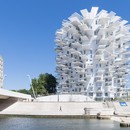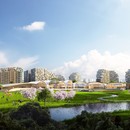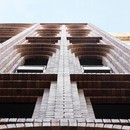Biography
One of today’s best-known Japanese architects, Sou Fujimoto (1971) graduated in Architecture from the Faculty of Engineering, University of Tokyo in 1994.
The majority of his work (initially projects for small spaces) is located in Japan, where he founded Sou Fujimoto Architects in 2000.
He gained recognition some years later, when he won the Architectural Review award for emerging architecture 3 years in a row. Fujimoto lectures at the Universities of Tokyo, Kyoto and Minato (Keio University).
Growing up on the Japanese island of Hokkaido, from childhood he explored the mountains and forests of Hokkaido island which engendered his interest in the natural world from an early age.
His lecture at the Architectural League of New York (2014) entitled “Between Nature and Architecture” defined the fundamental principles of his theoretical reflections. Inspired by organic and natural structures such as forests and caves, Fujimoto draws inspiration from these for an “ambiguous interpretation of space and form”, in a design philosophy defined as "primitive future".
In particular, for Fujimoto the cave represents "a raw space where function was determined based on human behavior" (R. Cole) and, more generally, in the complexity of the natural environment, “we inject our human sense of order (and vice versa), carrying forward a new definition of space which responds to the changing times”.
Another significant experience, confirmed by the architect himself during the Invisible Architecture conference (Roma, 2017), took place in the streets of Tokyo when Fujimoto was studying at university. Here, as in the forests of Hokkaido, spatiality was composed of apparently disconnected elements (street lamps, benches, distributors, wastebins and other street furniture), all of which contributed to creating a perception of the whole, visible and invisible, with equally important empty spaces.
These two places inspire his body of work, positioned between “nature and human artifice”, as evidenced in numerous projects in Japan, such as the T House (2005), whose almost flower-shaped layout consists of one big room with rooms radiating outwards, like petals. House O (2007) in glass and concrete, is located on a rocky stretch of land facing the Pacific Ocean.
N House (2008), with its concentric shell-shaped structure, blurs the boundaries between inside and outside, "with a series of progressively more intimate living spaces nested into one another".
Taking classic Japanese architectural traditions to the extreme, where rooms are separated only by sliding rice paper walls with no clear demarcation between interior areas, Fujimoto constructed an external concrete structure, with large unglazed windows, and two internal modules plus an outdoor space with trees, garden and wooden deck.
The Final Wooden House (2008), with huge wooden beams forming the walls, floor and roof, is a structure that encourages the occupants to interpret the spatiality according to their needs, due to the flexible use of the surface area.
The transparent NA House (2010), with glass walls is inspired by a treehouse, and comprises a single internal space, constructed on an external steel frame. "Simple yet essential, it is rich in design features and tricks (R. Zancan) and represents a clear desire to take construction to the extreme, in this case almost eliminating the demarcation between human artifice and the environment also on a purely visual level.
Non-residential projects include the Musashino Art University Museum & Library (2010), Tokyo, a compact building in the shape of a spiral that recalls an ark, characterized by large, enveloping walls made up of bookshelves.
The thinking behind integrating natural and architectural elements remains central, even in futuristic projects outside Japan. These include a fascinating, temporary, lattice structure reminiscent of a cloud, created for the Serpentine Gallery in London (2013) and which Fujimoto considers his best work.
Also known as "The Cloud” and relocated to Tirana in 2016 (and renamed Reja), the structure is inspired by organic shapes present in nature. Once again, the man-made and nature merge, in an "artificial nest". Formed by 20mm diameter steel bars, it is a flexible, semi-transparent structure, where visitors become an integral part of nature and the landscape yet at the same time remain protected inside.
10,000 square meter tower project. White tree (described as an “architectural folly of the 21st century”) has been under construction since 2014. The 17-storey, mixed-use skyscraper was designed to look like a tree which has grown in response to its surroundings. The project also includes a series of urban improvements, such as expanding the park along the river and optimizing roads.
In 2012, Fujimoto was a member of the team which won the Golden Lion at the Architecture Exhibition in Venice.
Sou Fujimoto selected works and projects
- House of Hungarian Music, Budapest (Ungheria), 2018 - in corso
- Naoshima Pavilion, Naoshima, Kagawa (Giappone), 2017
- Arbre Blanc, Montpellier, Montpellier (Francia), 2015 - in corso
- Padiglione della Serpentine Gallery, Hyde Park, Londra (Gran Bretagna), 2013
- Progetto di estensione del Museo Kunsthalle Bielefeld, Bielefeld (Germania), 2013
- House K, Nishinomiya (Giappone), 2012
- Museo della Musashino Art University, Tokyo (Giappone), 2011
- Biblioteca della Musashino Art University, Tokyo (Giappone), 2010
- House NA, Tokyo (Giappone), 2010
- Final Wooden House, Kumamoto, isola di Kyushu (Giappone), 2008
- House before House, Utsunomiya (Giappone), 2009
- Installazione L-finesse - Crystallised Wind, Milano (Italia), 2009
- House H, Tokyo (Giappone), 2009
- House N, Oita (Giappone), 2008
- Appartamento, Tokyo (Giappone), 2007
- House O, Tateyama (Giappone), 2007
- Centro infantile di riabilitazione psichiatrica, Date (Giappone), 2006
- Casa di cura per anziani, Noboribetsu (Giappone), 2006
- 7/2 house, isola di Hokkaido (Giappone), 2006
- House T, Gunma (Giappone), 2005
Official website:
http://www.sou-fujimoto.net
Related Articles: Sou Fujimoto
Related Articles









